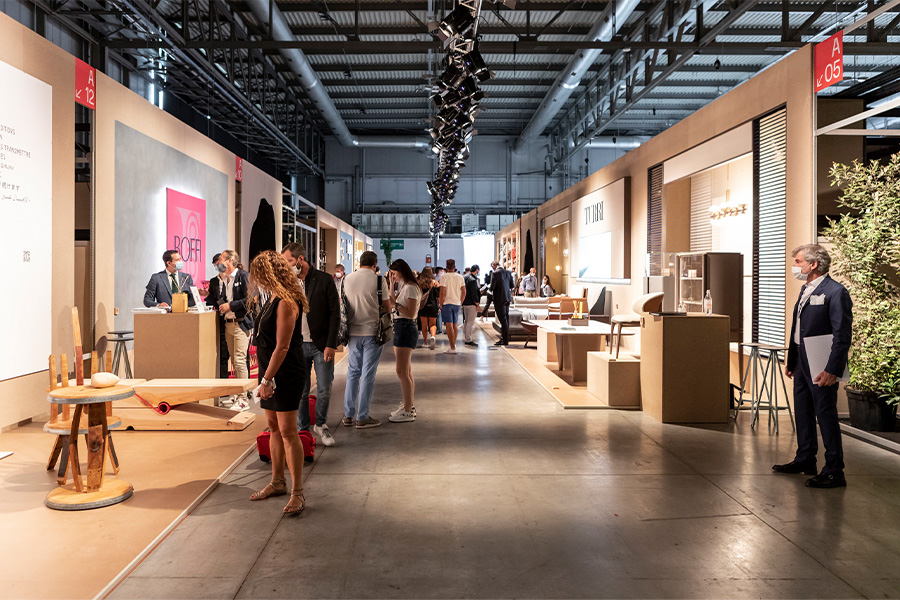Salone del Mobile returns to Milan, OMA completes its first religious building in California, and Anders Berensson Architects conceives the world’s largest timber structure. All that and more in this week’s Five on Friday.
Imagining the world’s largest timber structure

Anders Berensson Architects has unveiled renderings for the Bank of Norrland, which is conceived as the world’s largest timber structure. A conceptual design by the Swedish practice, the project would comprise a cubic kilometer that stores up to 900 million logs for future use. The design would prevent the release of large carbon dioxide emissions, ArchDaily reports. The concept is born out of Sweden’s ongoing efforts to reduce the consumption of oil-based products and become a fossil-free, climate neutral country. Bank of Norrland will be showcased in the Architecture of Transition exhibit at the Bildmuseet museum in Umeå, Sweden, which will be open to the public through March 2022.
OMA completes first religious project

Image courtesy of OMA New York, photo by Jason O’Rear
OMA has completed its design of the Audrey Irmas Pavilion at the Wilshire Boulevard Temple in Los Angeles. The project is the firm’s first in California and its first religious institution, Dezeen writes. Clad with 1,230 hexagonal panels—either stone or windows—the 55,000-square-foot structure is composed of glass fiber-reinforced concrete. The ribbed panels are designed to catch light differently and establish variations of character across the façade. Multifunctional facilities are housed onsite beside its neighboring congregation, from which it leans away in its trapezoid form.
Your cotton tote better be a lifetime commitment

If there’s anything those of us in design can agree on, it’s that we have incurred a small wealth of cotton tote bags over the years. However, this may not be as ideal an arrangement as previously thought. According to the New York Times, the amplification of cotton tote bags as a branding device has established a new environmental delay. To offset the overall environmental impact of one tote, a 2018 estimate says it must be used 20,000 times. This would equate to daily use for 54 years. To make matters worse, sustainable disposal of cotton totes presents a whole new challenge. Municipal composts do not accept the bags, and only 15 percent of the 30 million tons of cotton produced annually ever make it to textile depositories. But hope is not yet lost, thanks to designers and brands aiming to reinvent the bags we all so love.
Denver Art Museum set to create a Textile Art and Fashion Department

The exterior of the Denver Art Museum; photo by Maciek Lulko/Flickr
The Denver Art Museum has received a $25 million donation to support its creation of a new Textile Art and Fashion Department. According to Artforum, $10 million of the gift will go toward an endowment fund for new acquisitions in the department, while the remaining $15 million will fund an endowment for scholarship and programming. The museum’s Textile Art and Fashion department was first seeded in 1927 and officially formed in 1955. The gallery housing the collection was renovated in 2016 while endowed by the Avenir Foundation. The collection, which has grown significantly under the leadership of Florence Müller, who serves as the Avenir Curator of Textile Art and Fashion, comprises nearly 5,000 objects.
Salone del Mobile makes its return to Milan

Photo by Andrea Mariani
After multiple postponements, Salone del Mobile reemerged in Milan this past week to present Supersalone, a five-day exhibition curated by Italian architect Stefano Boeri that concludes today. The event, which was scaled down in comparison to Salone’s typical fairs, took place within four of Fiera Milano’s pavilions and showcased more than 1,900 projects from 425 brands, 170 emerging creatives, and 39 makers. Special highlights included the Lost Graduation Show, which displayed the work of design students who graduated between 2020 and 2021; the Makers Show, which was dedicated to self-producing, independent designers from across the world that combine experimentation with new production techniques and research; and the Take Your Seat installation, which featured 130 chairs to demonstrate the role chairs have played—and its many design iterations—as a result of societal and cultural shifts.



